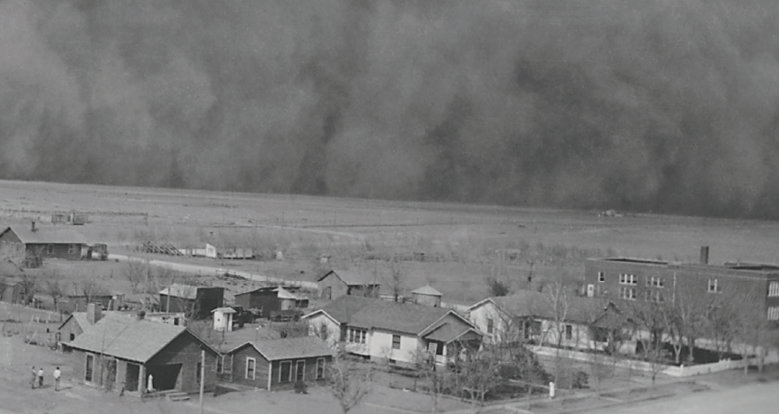

Aug 26, 2019Jerry Mills: Remembering the Dust Bowl climate of the 1930s
July hot temperatures helped grain crops to catch up. It is too soon to judge the fruit. We have had peaches that look ripe for two weeks, but remain hard, waiting for the calendar, I guess.
Wheat harvest finished between rains but second crop of beans remain stalled in the planters, where they were when the deluges began. Still, soil was too dry to plant pumpkins, now almost too late and too wet.
On the positive side, hay harvest was good. We got it in between rains, even baling our big parking lot. It had been too wet to mow. Grass was almost two feet high.
Wet weather that prevented proper pest control on the fruit opened up just enough to spray at proper times, and I have the cleanest crop in years. Will it last? I sure hope so.
Does anyone remember the Dust Bowl? I do. It was in the mid-1930s. My family lived outside Albion, Nebraska, on what had once been a beautiful farm. We had a horse barn and cattle barns for our one cow, large enclosed feedlots and 320 acres of land on the eastern edge of the Nebraska sand hills.
The big house had a self-contained electrical system with a diesel engine in the basement and a place for banks of glass batteries on shelves. A wind-driven generator stood high on a pole in the back yard. The house had two inside bathrooms, one downstairs and the other up. However, by the time we moved there the batteries and the upstairs toilet were gone. We used kerosene lamps. The kitchen was bare except for a cast iron sink.
We lived a mile from town. I could walk to school, but I tried to hitchhike whenever I could. That lasted until the neighbors told on me. Can you imagine a seven-year-old begging for rides on a country road these days?
That year, 1937, was particularly hot and dry. My dad planted 160 acres of corn. It grew a foot high and stopped. Grasshoppers appeared literally in clouds, sometimes riding the winds high above the ground. The government gave us poisoned bran for bait. Chinch bugs showed up. The way to keep them out of a field was to plow a furrow around it. Chinch bug crawlers could not climb up the steep side of the furrow. Both insects played havoc with what green crops were available.
The year started pleasantly enough. There was enough moisture to plant crops and the sandy soil worked well. Then the winds came and the rains left. It seemed as if every week there was a sand storm. It sifted around the windows and left piles on the sills.
Dust was coming from places that should never been plowed. Places like western Oklahoma, Texas, Kansas and western Nebraska began to lose millions of tons of topsoil. It blew all the way to the East Coast, darkening skies as it went.
The way it worked was like this: Wind would dislodge particles of sand and send them racing across hard-packed topsoil. The effect was the same as running sandpaper and the dust was just as fine.
Western farmers eventually learned to plant crops in large strips and farm them every other year, and to till row crops every other row after rains. The clods raised by tilling stopped blowing sand from eroding smooth surfaces.
Went in for a heart tune-up last month. The nurse asked if I wanted my pulse turned down, from 90 beats to something not so vigorous. Sure, I said, and she pushed buttons in her laptop screen and my heart responded. The idea that someone can change pulse rate by remote control is great, thanks to the battery-controlled defibrillator planted in my chest.
My son even manages his diabetes this way. His phone tells him his insulin/blood sugar is off limits. He fixes it by telling his phone to tell a machine in his body to feed in more insulin, and it does. Amazing.
Our cemetery. It is not really ours but we manage it. It sets on one corner of the farm. The first grave is dated 1847. Burials often are in clusters. Groups arrived after cholera and diphtheria swept through the neighborhoods. There are many sad stories associated with those 100 graves.
Anyway, several years ago I announced to my family that we could accommodate anyone needing a burial plot. Since most of our family are scattered over the entire country with no real local connections, many have responded. To date we have my wife, my son, my parents and my little sister buried here. Another sister is planning to come. Even though I do not have strong religious feelings, it is comforting to have the whole clan reuniting. We have eight plots reserved for the rest of us. I hope we do not fill them too soon.
There is even one unidentified Civil War sailor. Our own rock of an unknown soldier.
– Jerry Mills, Mills Apple Farm
“Notes from the Farm,” a collection of columns written by beloved grower Jerry Mills, will be for sale at the Great Lakes Fruit, Vegetable & Farm Market EXPO (Booth 949). Copies are $20, with a portion of the proceeds from book sales being donated to the Michael J. Fox Foundation.















